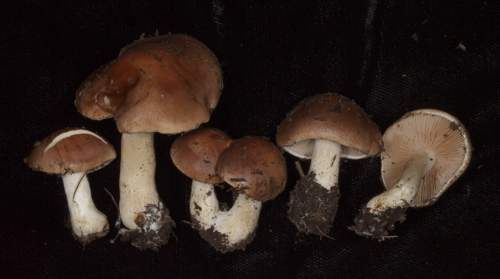 Hebeloma cinnamomeum (Photo: K. Hosaka)
Hebeloma cinnamomeum (Photo: K. Hosaka)Taxonomy
Full name: Hebeloma cinnamomeum Beker & U. Eberh., Mycol. Prog. 21: 462 (2022)Genus: Hebeloma
Section: Denudata
Subsection: Clepsydroida
Types: JAPAN: Ishikawa, Wajima-shi, Mii-machi, Nakanagatani (approx. 37.3084°N, 136.93°E, alt. approx. 230 m a.s.l.) under Pinus densiflora, Quercus serrata and Quercus variabilis, 16 Oct. 2016, T. Kasuya (B3261) (Holotype. herbarium acc. no. TNS-F-82067, HJB15837).
- arrow_drop_downarrow_drop_upEtymologyfrom cinnamomeus (adj. Latin) describing the cinnamon coloured pileus.
- arrow_drop_downarrow_drop_upDiagnosisThe cinnamon-colored pileus, the spores with average Q less than 1.85 and the cheilocystidia with average width near the apex of less than 6.5 μm, are characters that separate this species from others in H. sect. Denudata.
References
Description
- arrow_drop_downarrow_drop_upThresholds
Description of Hebeloma cinnamomeum based on 34 collections
- arrow_drop_downarrow_drop_upMacroscopic descriptionPileus: (20) 21–46 (51) mm diameter; shape often convex, occasionally umbonate or umbilicate, rarely broadly umbonate; characters Not recorded; margin characters involute; viscosity tacky when moist; colour variation usually unicolour, rarely two color; colour at centre usually cinnamon, rarely brick.
Lamellae: attachment emarginate; maximum depth up to 4 mm; number of complete lamellae 52–64; presence of tears absent; white fimbriate edge present.
Cortina presence: no.
Stipe: (24) 30–60 (64) x 4–8 (11) {median} x 5–10 (11) {basal} mm; stipe Q 4.0–11.3; base shape often clavate, occasionally cylindrical; floccosity pruinose at apex, occasionally velute; rooting no; thick rhizoids at base absent;
Context: Texture firm; stipe interior Not recorded; stipe flesh discolouring often no, occasionally weak; slenderness measure 4.0–25.3; smell Not recorded; taste Not recorded.
Spore deposit colour: Not recorded.
Exsiccata characters: Not recorded.
- arrow_drop_downarrow_drop_upMicroscopic descriptionSpores: shape amygdaloid, occasionally limoniform; colour in microscope yellow brown; guttules often yes or weak. papilla variable occasionally weak; Spore Code: O2 O3; (P0) P1; (D1) D2.
Basidia: (21) 22–33 (34) x 6–8 μm; ave. Q 3.0–3.9; spore arrangement 4 spored;
Cheilocystidia: main shape clavate-lageniform or clavate-ventricose, rarely clavate-stipitate; special features observed often median thickening, occasionally septa, rarely yellow contents; cheilocystidia ratios: A/M = 1.42–1.81; A/B = 0.86–1.37; B/M = 1.35–1.86.
Pleurocystidia: none seen.
Ixocutis: epicutis thickness (measured from exsiccata) up to 160 μm; ixocutis hyphae width up to 6 μm; ixocutis hyphae encrustation yes; shape of trama elements beneath subcutis cylindrical or ellipsoid, often thickly sausage-shaped up to 12 μm wide.
Caulocystidia: Similar to cheilocystidia but larger, up to 110 μm.
- arrow_drop_downarrow_drop_upSpore measurements
- arrow_drop_downarrow_drop_upCheilocystidia measurements
- arrow_drop_downarrow_drop_upHabitat and distributionHebeloma cinnamomeum's preferred habitat appears to be deciduous woodland or woodland. Where only one possible associate was recorded, the most commonly recorded associate was Quercus (60.0%) but Pinus (40.0%) were also recorded. In these cases the most commonly recorded families were Fagaceae (60.0%) and Pinaceae (40.0%). We have additional records where Carpinus (12.5%) and Fagus (12.5%) were recorded as possible associates, but in these cases a number of possible associates were mentioned. Overall the most commonly recorded families are Fagaceae (62.5%), Pinaceae (37.5%) and Betulaceae (12.5%) The growth habit of our collections was often scattered and occasionally caespitose or solitary.
According to our current collections, the species is found only in Asia-Temperate. On the continent, collections have been found only in the temperate broadleaf & mixed forests WWF biome The World Wildlife Fund (WWF) have divided the world into 867 terrestrial ecoregions. The ecoregion here is estimated by mapping from the GPS coordinates of the collection using data made available by Dinerstein et al (2017). Use this webtool to explore the ecoregions visually or see a full list of current ecoregions on Wikipedia. (Taiheiyo evergreen forests (52.9%) and Eastern Himalayan broadleaf forests (32.4%) ecoregions). From collector information, it appears collections have been found only in the 1.4 Forest – Temperate IUCN habitat We map from the collector's description of the habitat to the International Union for Conservation of Nature (IUCN)'s definition using a standardised set of rules. Please see this page for a full list of IUCN habitats.. Within Temperate Asia all our records are from Eastern Asia (Japan).
- arrow_drop_downarrow_drop_upCommentaryThe mainly clavate-ventricose cheilocystidia together with distinctly ornamented spores support the placement of this taxon in H. subsect. Clepsydroida within H. sect. Denudata. The occasional presence of cystidia with thickening of the wall in the middle is further evidence of this placement. All loci apart from mitSSU V6 support a shared lineage of H. cinnamomeum with H. cavipes (the type species of H. subsect. Clepsydroida) rather thanwith H. crustuliniforme (the type of H. subsect. Crustuliniformia) or H. hiemale (the type of H. subsect. Hiemalia). Within H. sect. Denudata, the spores with average Q less than 1.85, the cheilocystidia with average width near the apex of less than 6.5 μm and the cinnamon-colored pileus are characters that separate this species from others within this subsection. The pileus color is an eye-catching feature that may well enable field identification, or at least a reasonable suspicion of determination, of this species. While our morphological description is based on 23 collections, many (but not all) are from a relatively confined area within the Tsukuba Botanical Garden, which is planted with endogenous plants from Japan. The description provided may be too narrow, given the similar habitat for many of these collections. In addition, a sequence from a Quercus dentata root tip collected in Hokkaido (LC068995, Arai et al. unpublished, submitted27-Jul-2015)clustersinMLanalyses(notshown)withH. cinnamomeum sequences, supporting the assumptions on associates and adding evidence that it is an endogenous species in Japan. Thissequencecurrently (9June2021)formsa singletonUNITESH hypothesis (SH2292369.08FU) at the < 0.5% level, but owing to probable editing errors in this sequence this SH has to be treated with caution. Note that cited collection TNS-F-44863 was originally identified as Hebeloma microsporum, the name under which it is recorded on GBIF, and whichwas mentioned in the introduction. Japanese name: Mizuho-wakafusa-take (Eberhardt et al. 2022).
Geographic distribution
Phenology
- arrow_drop_downarrow_drop_upAdditional cited collections